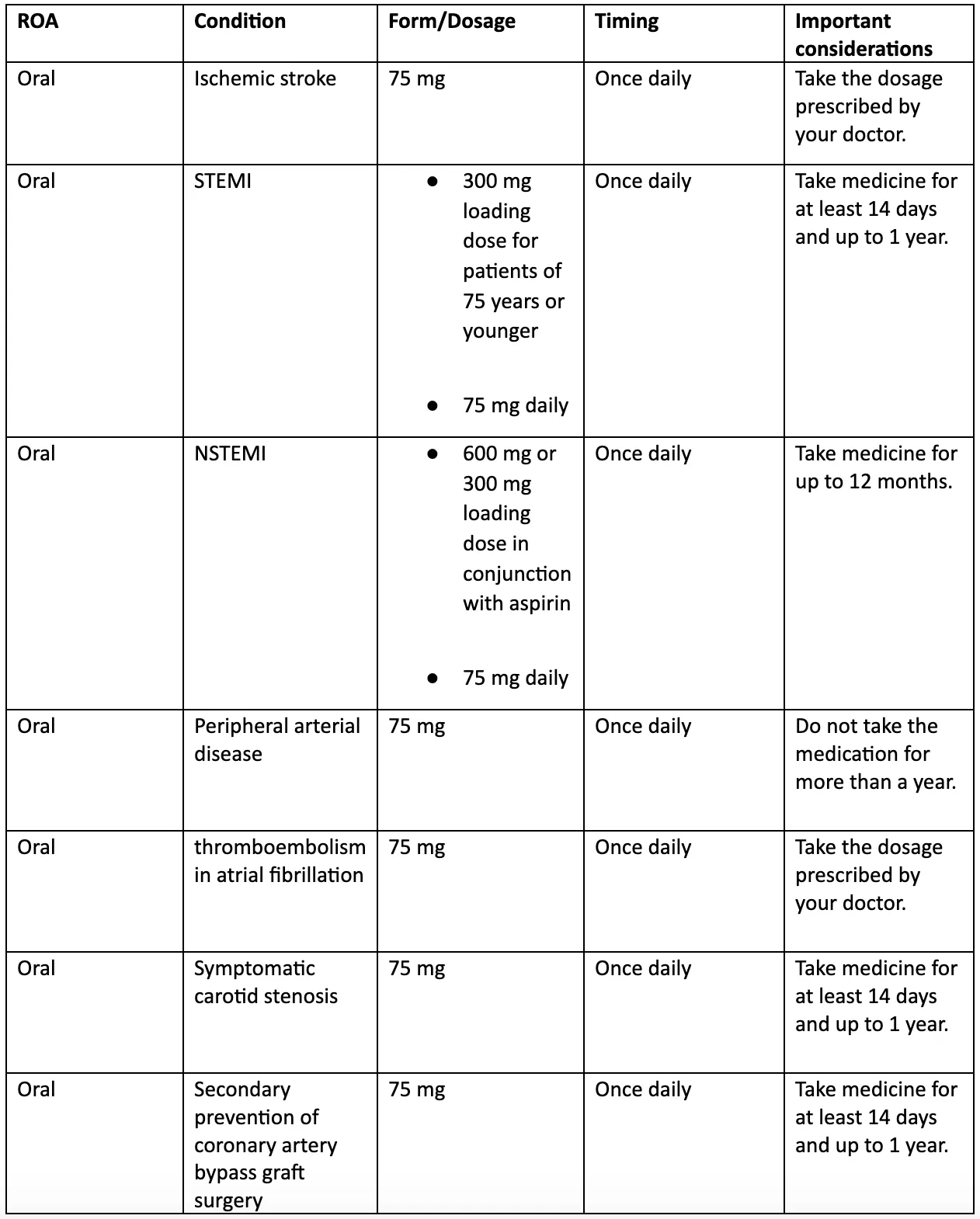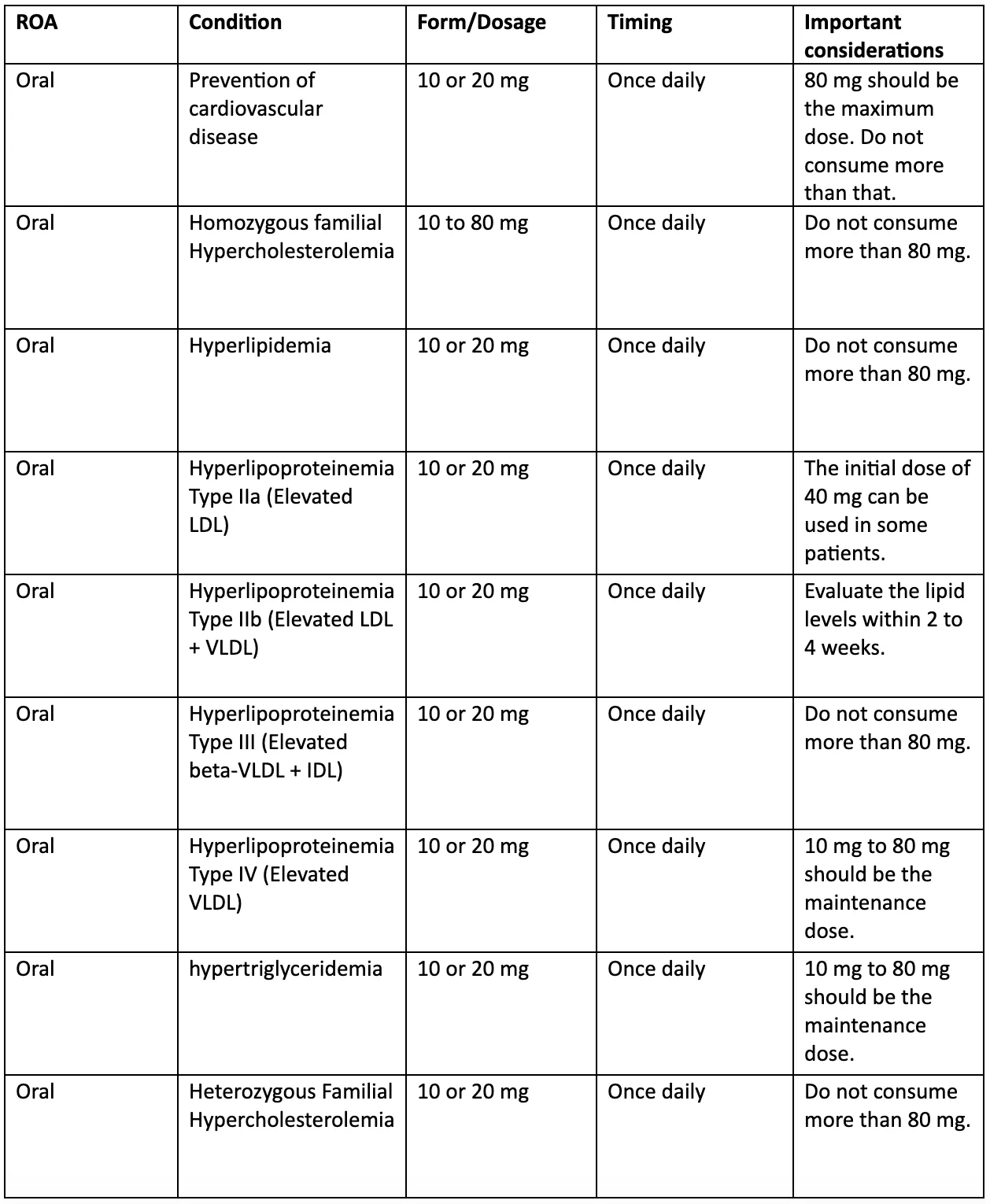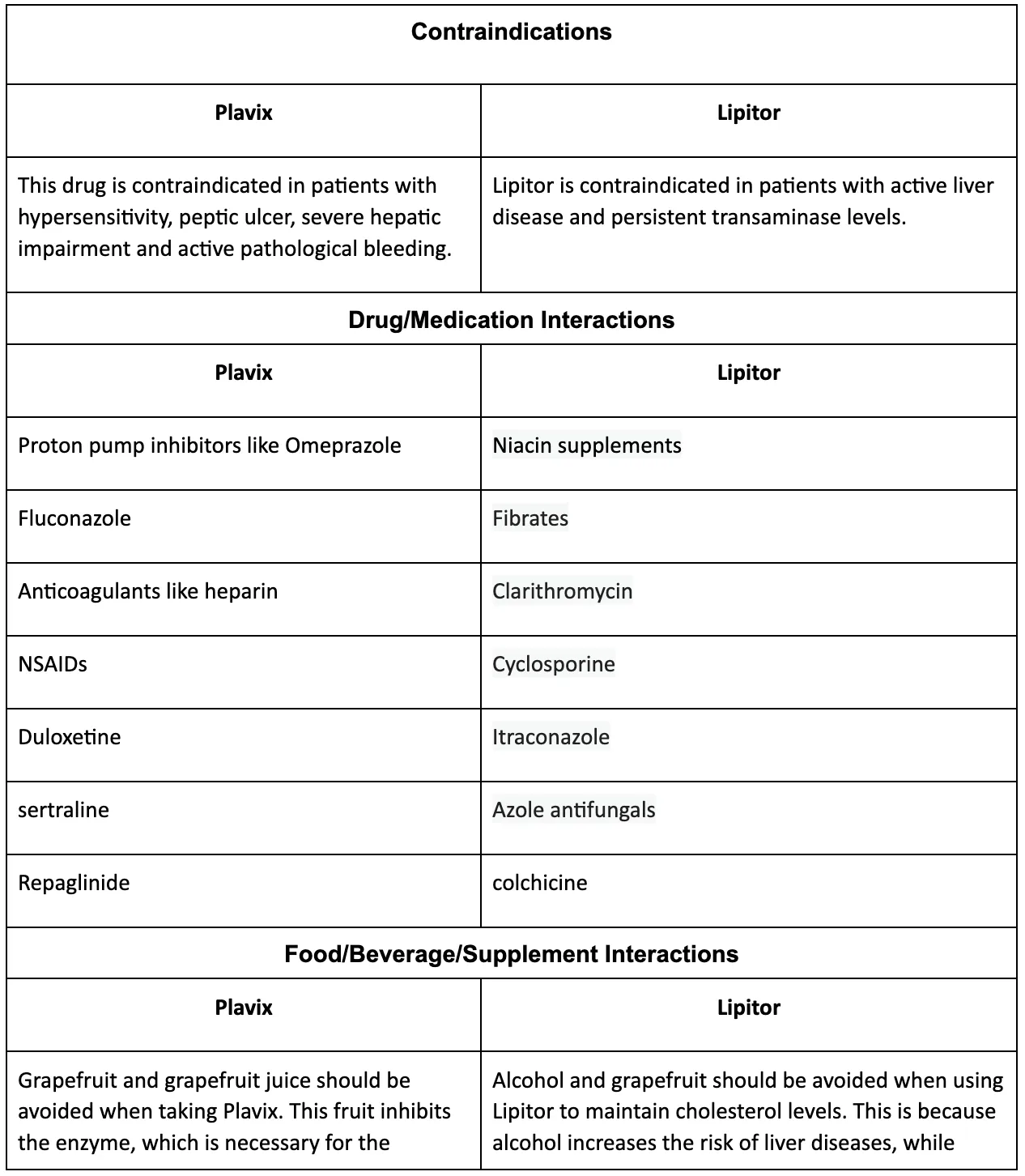Your session is about to expire
Plavix vs Lipitor
Introduction
Plavix and Lipitor are commonly prescribed medicinal drugs that help with improving heart health by serving different purposes.
Plavix is a well-known antiplatelet drug commonly known by its name, Clopidogrel. This is an effective medicine that works to prevent blood clots and is prescribed to individuals who recently had a heart attack or stroke. Nevertheless, it helps with a couple of other heart and blood vessel conditions as well.
Lipitor, on the other hand, is known by its name atorvastatin and belongs to the class of drugs known as statins. Statins help in reducing the complications related to the heart and lower cholesterol levels.
This tells us that both Plavix and Lipitor are important drugs that help improve cardiovascular health but in different ways.
About Plavix and Lipitor
What is Plavix?
Plavix is classified as an antiplatelet drug, which prevents platelet sticking in your blood. This helps prevent the formation of blood clots, which could otherwise block an artery. Depending on the artery it blocks, a person may get conditions like stroke, heart attack, etc.
Individuals with a previous history of heart problems or poor cardiovascular health are usually recommended to use Plavix. This drug is prescribed in combination with other medications like aspirin to get the desired results.
Administrating Plavix helps to lower the risk of blood clot formation, heart problems, stroke, angina, and other circulation problems.
What conditions are Plavix approved to treat?
Plavix was approved by the Food and Drug Administration in 1997. It helps improve the heart condition of patients who have a previous history of heart disorders like stroke, heart attack, etc. Plavix comes in different strengths and can be bought on a doctor's prescription.
Plavix is approved to treat the following conditions:
- Ischemic stroke
- Peripheral arterial disease
- Unstable angina
- ST-segment elevation myocardial infarction (STEMI)
- Non-ST-segment elevation Myocardial infarction (NSTEMI)
- acute coronary syndrome
- atrial fibrillation
How does Plavix work for cardiovascular conditions?
Platelets are a type of blood cell that have a role in blood clotting. They reach the site where a blood vessel has been damaged to recover it. Platelets get activated, clump together, and form a clot. This stops the bleeding at the site of injury. While this mechanism is a blessing, it can become a curse if excessive platelet activation occurs and form clots. It will resultantly block the blood vessels and increase the risks of conditions like stroke and heart attacks.
Plavix has Clopidogrel as an active ingredient, which is an inhibitor of the receptor name P2Y(12) adenosine diphosphate. This receptor is present on the surface of platelets. Clopidogrel inhibits this receptor irreversibly, thus preventing the activation of the glycoprotein IIb/IIIa receptor complex. This leads to reduced platelet aggregation and, thus, blood clot formation.
What is Lipitor?
Lipitor has a common name, atorvastatin, that belongs to a class of drugs called statins. They help in improving cardiovascular health by maintaining cholesterol levels. The dosage of Lipitor is recommended considering the risk factors and lipid profile of the patient.
Lipitor helps with high cholesterol levels and works by inhibiting a certain enzyme that plays a role in cholesterol synthesis. As Lipitor blocks this enzyme, there will be a decrease in the concentration of LDL cholesterol levels.
What conditions is Lipitor approved to treat?
The US Food and Drug Administration approved Lipitor in 1996. This drug helps with a number of heart conditions as it maintains cholesterol levels.
The following are the conditions that Lipitor helps with:
- Heart diseases
- Stroke
- Prevent the risk of developing heart disease
- Hyperlipidemia
- Hypertriglyceridemia
- Hyperlipoproteinemia Type IIa (Elevated LDL)
- Hyperlipoproteinemia Type IIb (Elevated LDL + VLDL)
- Hyperlipoproteinemia Type III (Elevated beta-VLDL + IDL)
- Hyperlipoproteinemia Type IV (Elevated VLDL)
- Homozygous Familial Hypercholesterolemia
- Heterozygous Familial Hypercholesterolemia
How does Lipitor work for Cardiovascular Conditions?
Cholesterol is synthesized in our liver with the help of an enzyme called HMC-CoA reductase. There will be no cholesterol production in our body if this enzyme doesn’t exist.
When Lipitor is administrated in our body, it instantly inhibits the action of the enzyme HMC-CoA reductase. This enzyme is basically responsible for converting HMG-CoA to mevalonate. Lipitor inhibits this conversion and prevents the formation of cholesterol.
There are LDL receptors on the surface of liver cells. Lipitor also increases these receptors that cause the reduction in LDL cholesterol levels. As a result, there is a reduced risk of cardiovascular conditions like heart attack and strokes.
It is crucial to note that Lipitor specifically inhibits the synthesis of cholesterol only and has no effect on other lipid molecules.
Effectiveness
How effective are Plavix and Lipitor for treating Cardiovascular Conditions?
Plavix does its job within two hours of intake. However, a maintenance dose should be consumed regularly to prevent platelet aggregation. When it takes longer for the bleeding to stop, it is an indication that Plavix is rightly working.
Lipitor, on the other hand, takes 2 to 4 weeks to maintain the cholesterol levels. The medicine should be taken in the prescribed amount for the given time.
Dosage information
How is Plavix administered for Cardiovascular Conditions?
Plavix is available in the form of tablets only that should be consumed orally. However, the exact dosage and time duration depend on the condition that is needed to be treated. Plavix is available in two strengths:
- 300 mg – typically used as a loading dose
- 75 mg – used as a maintenance dose regularly
Plavix dosage information

How is Lipitor administered for Cardiovascular Conditions?
Lipitor is administrated orally and is available in different strengths. They are 10 mg, 20 mg, 40 mg, and 80 mg. The maintenance dose is usually 10 mg to 20 mg. No more than 80 mg should be consumed in a day.
Lipitor dosage information

Side Effects
What are the most common side effects of Plavix?
You may experience the following side effects of Plavix when using it:
- Fever
- Muscle pain
- Confusion
- Itching
- Skin rash
- Nose bleeding
- Headache
- Fatigue
- Shortness of breath
Are there any potential serious side effects of Plavix?
Plavix also has some serious side effects. It may include:
- Stroke
- Blood in stool and urine
- Fast heartbeat
- Purple spot under the skin
- Jaundice
- Low blood sugar causes anxiousness and dizziness
You should immediately get medical help when you experience any of these side effects.
What are the most common side effects of Lipitor?
The following are the most common side effects of Lipitor:
- Nausea
- Headache
- Nose bleed
- Sore throat
- Runny nose
- Stomach pain
- Urinary tract infection
- Constipation
- Difficult falling asleep
Are there any potential serious side effects of Lipitor?
You may feel some serious side effects when using Lipitor. Some of them are:
- Fatigue
- Myopathy
- Allergic reactions
- Muscle spasms
- Joint pain
- Abnormal liver function
- Difficulty climbing stairs
A person should immediately seek medical help when noticing any of these side effects. Otherwise, they can progress into much more severe complications.
Contraindications and interactions
Warnings and general precautions for Plavix and Lipitor
Serious drug interaction can occur when you consume Plavix and Lipitor with certain medications. Therefore, it is necessary to tell your doctor about every medicine you use.
Plavix should be avoided when you have active bleeding, such as stroke and stomach ulcer. This is because Plavix increases the risk of bleeding, which will be life-threatening for the patient.
Similarly, Lipitor should not be administrated if you have any liver disorder. It can also lead to kidney failure and the breakdown of muscle tissues. Immediately let your doctor know if you come across such a situation.
Contraindications and important interactions for Plavix and Lipitor


Cost Comparison
How much do Plavix and Lipitor cost?
The cost of medicines varies considerably depending on the pharmacy and location. Given below is the approximate price for both Plavix and Lipitor.
Plavix
- 75 mg Plavix costs $753 for 90 oral tablets
- 300 mg Plavix costs $101 for 20 oral tablets
Lipitor
- 10 mg of Lipitor costs $1,178 for 90 tablets.
- 20 mg of Lipitor costs $1,677 for 90 tablets.
- 40 mg of Lipitor costs $1,677 for 90 tablets.
- 80 mg of Lipitor costs $1,255 for 64 tablets.
Popularity of Plavix and Lipitor
Plavix and Lipitor are medicinal drugs that have been widely described for managing cardiovascular conditions. Though they have a common goal, the focus and mechanism of action are completely different. Therefore, there is also a significant difference in their popularity.
Plavix has estimated 4 million users in the US in 2020, while Lipitor had 26 million users in the US in 2020. Lipitor (Atorvastatin) has been ranked the number 1 drug since 2018.
These ratings tell how Lipitor is the most prescribed and used medicinal drug in the US for maintaining cholesterol levels.
Conclusion
Takeaway
In conclusion, Plavix and Lipitor have been very helpful in maintaining cardiovascular health, but they have quite different focuses and mechanisms of action.
Plavix is an antiplatelet that prevents blood clots and thus reduces the risk of heart attack, stroke, and several other blood vessel disorders. On the other hand, Lipitor maintains cholesterol levels and prevents coronary artery diseases.
However, it is necessary to consult a healthcare professional for the diagnosis of the disease and appropriate medication selection.